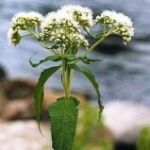| Common Name: |
Teasel |
| Other Names: |
Agueweed, Boneset, Crosswort, Feverwort, Indian Sage, Sweat Plant, Thoroughwort. |
| Botanical Name: |
Eupatorium perfoliatum |
| Genus: |
Eupatorium |
| Family: |
Asteraceae |
| Native Location: |
SE USA |
| Cultivation: |
Moist soul in sun or partial shade. Cut stems almost to ground level in autumn after flowering. Eupatorium purpureum prefers alkaline soil. Some species are subject to statuatory controls as weeds in parts of Australia. |
| Propagation: |
By seed sown in spring; by division in spring. |
| Harvest: |
Plants are cut when in bud, and dried for use in infusions, liquid extracts, tinctures. Rhizomes and roots are lifted in autumn, and dried for use in decoctions or tinctures. |
| Height: |
1.5m (5ft) |
| Width: |
30cm-1m (1-3ft) |
| Hardiness: |
Z3-8 |
| History: |
Named for King Eupator of Persia, and esteemed herbalist of the first century BCE, Eupatorium perfoliatum, more commonly known as boneset, was famously used by the Native Americans for aches and pains, colds and fevers. European settlers in the New World adopted the herb with a passion, and by the nineteenth century it was the most popular and widely used of the patented herb medicines for any infectious illness with fever and pain. The herb's common name has nothing to do with mending broken bones. Instead, boneset was one of the more effective early treatments for breakbone fever, also known as dengue or blackwater fever, a mosquito-born, acute viral infection—which originated in the tropics and migrated to the American colonies—characterized by very high fever and intense joint pain. |
| Parts Used: |
Whole Plant, Leaf, Flower |
| Properties: |
A bitter, astringent herb that lowers fevers, releives bronchial congestion and constipation, and stimulates the immune system. |
| Medicinal Uses: |
Internally for influenza, colds, acute bronchitis, mucus, and skin diseases. Combined with Achillea millefolium (See, yarrow), Asclepias tuberosa (see, milkweed), Sambucus nigra (see, common elder), Zingiber officinale (see, ginger), and/or Capsicum annuum (See, bell pepper) for influenza.
To treat the flu and other diseases involving fever.
Boneset is a tonic and mild stimulant with emetic, fever-reducing, laxative, pain-relieving, and sweat-inducing properties. It is frequently prescribed for the acute phases of cold and flu infections to treat accompanying congestion, coughs, fever, and pain. Boneset is also used to relieve the pain of arthritis and rheumatism.
An advisory: There is some debate among researchers who specialize in plant study—notably those scientists affiliated with the pharmacy departments of major universities—about the usefulness of boneset today. Some declare it worthless and even dangerous. Many other herbalists believe boneset is an effective, short-term treatment for acute viral infections with fever, and the herb is still featured in most herbal compendiums. |
| Preparation: |
To make a tea, pour 1 cup of boiling water over 2 teaspoons of dried herb and steep for 15 minutes. Strain. During the acute phases of a cold or flu, drink 1 cup every half hour (hot as you can stand), up to 4 cups in a 6-hour period. Do not drink more than 6 cups a day. Boneset has a very bitter taste that can be masked with the addition of honey and lemon. |
| Caution: |
Boneset should be used with caution and preferably under the advice of a qualified practitioner. Take the herb only at prescribed doses and never for more than two weeks at a time. High doses may cause diarrhea or nausea. Use only dried herb. The fresh plant contains a potent toxin called tremerol that can cause rapid breathing and vomiting, and at high doses, possibly coma and death. Drying the herb destroys the tremerol. Boneset can be toxic to the liver. If you have a history of alcohol abuse or liver problems, consult your practitioner before using the herb. |
| Possible Side Effects: |
Boneset's side effects include loss of appetite, diarrhea, nausea, and vomiting. |
| Drug Interactions: |
| Taking boneset with these drugs may cause or increase liver damage |
| Abacavir, (Ziagen) |
Acarbose, (Prandase, Precose) |
Acetaminophen, (Genepap, Tylenol) |
Allopurinol, (Aloprim, Zyloprim) |
Atorvastatin, (Lipitor) |
| Celecoxib, (Celebrex) |
Cidofovir, (Vistide) |
Cyclosporine, (Neoral, Sandimmune) |
Docetaxel, (Taxotere) |
Dofetilide, (Tikosyn) |
| Erythromycin, (Erythrocin, Staticin) |
Etodolac, (Lodine, Utradol) |
Fluconazole, (Apo-Fluconazole, Diflucan) |
Fluphenazine, (Modecate, Prolixin) |
Fluvastatin, (Lescol) |
| Foscarnet, (Foscavir) |
Ganciclovir, (Cytovene, Vitrasert) |
Gemfibrozil, (Apo-Gemfibrozil, Lopid) |
Gentamicin, (Alcomicin, Gentacidin) |
Ibuprofen, (Advil, Motrin) |
| Indinavir, (Crixivan) |
Isoniazid, (Isotamine, Nydrazid) |
Ketoconazole, (Apo-Ketoconazole, Nizoral) |
Ketoprofen, (Orudis, Rhodis) |
Ketorolac, (Acular, Toradol) |
| Lamivudine, (Epivir, Heptovir) |
Levodopa-Carbidopa, (Nu-Levocarb, Sinemet) |
Lovastatin, (Altocor, Mevacor) |
Meloxicam, (MOBIC, Mobicox) |
Methotrexate, (Rheumatrex, Trexall) |
| Methyldopa, (Apo-Methyldopa, Nu-Medopa) |
Morphine Hydrochloride, (Morphine Hydrochloride) |
Morphine Sulfate, (Kadian, MS Contin) |
Naproxen, (Aleve, Naprosyn) |
Nelfinavir, (Viracept) |
| Nevirapine, (Viramune) |
Nitrofurantoin, (Furadantin, Macrobid) |
Odansetron, (Zofran) |
Paclitaxel, (Onxol, Taxol) |
Pantoprazole, (Pantoloc, Protonix) |
| Phenytoin, (Dilantin, Phenytek) |
Pioglitazone, (Actos) |
Piroxicam, (Feldene, Nu-Pirox) |
Pravastatin, (Novo-Pravastatin, Pravachol) |
Prochlorperazine, (Compazine, Compro) |
| Propoxyphene, (Darvon, Darvon-N) |
Repaglinide, (GlucoNorm, Prandin) |
Rifampin, (Rifadin, Rimactane) |
Rifapentine, (Priftin) |
Ritonavir, (Norvir) |
| Rofecoxib, (Vioxx) |
Rosiglitazone, (Avandia) |
Saquinavir, (Fortovase, Invirase) |
Simvastatin, (Apo-Simvastatin, Zocor) |
Stavudine, (Zerit) |
| Tamoxifen, (Nolvadex, Tamofen) |
Tramadol, (Ultram) |
Zidovudine, (Novo-AZT, Retrovir) |
|
| Bibliography: |
Encyclopedia of Herbs by Deni Brown Copyright © 1995, 2001 Dorling Kindersley Limited Pp 208-209
The Essential Herb-Drug-Vitamin Interaction Guide by Geo. T. Grossberg,MD and Barry Fox,PhD Copyright©2007 Barry Fox,PhD Pp.93-94
The Modern Herbal Primer by Nancy Burke Copyright©2000 Yankee Publishing, Inc. pp.44-45 |
